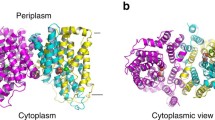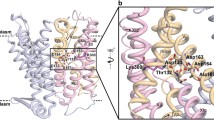Abstract
The genome of Vibrio cholerae encodes three cation–proton antiporters of NhaP-type, Vc-NhaP1, 2, and 3. To examine physiological roles of Vc-NhaP antiporters, triple ΔnhaP1ΔnhaP2ΔnhaP3 and single ΔnhaP3 deletion mutants of V. cholerae were constructed and characterized. Vc-NhaP3 was, for the first time, cloned and biochemically characterized. Activity measurements on the inside-out membrane vesicle experimental model defined Vc-NhaP3 as a potassium-specific cation–proton antiporter. While elimination of functional Vc-NhaP3 resulted in only minor growth defect in potassium-rich medium at pH 6.0, the triple Vc-NhaP mutant demonstrated severe growth defects at both low and high [K+] at pH 6.0 and failed to grow at high [K+] in mildly alkaline (pH 8.0 and 8.5) media, as well. Expressed from a plasmid, neither of the Vc-NhaP paralogues was able to complement the severe potassium-sensitive phenotype of the triple deletion mutant completely. Vc-NhaP1 provided much better complementation at acidic pH compared to Vc-NhaP2, despite the fact that Vc-NhaP2 showed much higher antiport activity in sub-bacterial vesicles. In mildly alkaline pH only Vc-NhaP2 complemented the potassium-sensitive phenotype of the triple deletion mutant. Taken together, these data suggest that in vivo all three isoforms operate in concert, contributing to K+ resistance of V. cholerae. We suggest that the Vc-NhaP paralogue group might play a role in passing gastric acid barrier by ingested V. cholerae cells.








Similar content being viewed by others
References
Häse CC, Fedorova N, Galperin MY, Dibrov P (2001) Sodium cycle in bacterial pathogens. Evidence from cross-genome comparisons. Microbiol Mol Biol Rev 65:353–370
Resch CT, Winogrodzki JL, Häse CC, Dibrov P (2011) Insights into the biochemistry of the ubiquitous NhaP family of cation/H+ antiporters. Biochem Cell Biol 89:130–137
Häse CC, Mekalanos JJ (1999) Effects of changes in membrane sodium flux on virulence gene expression in Vibrio cholerae. Proc Natl Acad Sci USA 96:3183–3187
Häse CC, Barquera B (2001) Role of sodium bioenergetics in Vibrio cholerae. Biochim Biophys Acta 1505:169–178
Resch CT, Winogrodzki JL, Patterson CT, Lind EJ, Quinn MJ, Dibrov P, Häse CC (2010) Putative Na+/H+ antiporter of Vibrio cholerae, Vc-NhaP2, mediates the specific K+/H+ exchange in vivo. BioChemistry 49:2520–2528
Wiens EJ, Winogrodzki JL, Resch CT, Orriss GL, Stetefeld J, Dibrov P (2014) The C-terminal cytoplasmic portion of the NhaP2 cation-proton antiporter from Vibrio cholerae affects its activity and substrate affinity. Mol Cell Biochem 389:51–58
Epstein W (2003) The roles and regulation of potassium in bacteria. Prog Nucleic Acid Res 75:293–320
Radchenko MV, Waditee R, Oshimi S, Fukuhara M, Takabe T, Nakamura T (2006) Cloning, functional expression and primary characterization of Vibrio parahaemolyticus K+/H+ antiporter genes in Escherichia coli. Mol Microbiol 59:651–663
Quinn MJ, Resch CT, Sun J, Lind, EJ, Dibrov P, Häse CC (2012) NhaP1 is a K+(Na+)/H+ antiporter required for growth of Vibrio cholerae at low extracellular pH. Microbiology (UK) 158:1094–1105
Mekalanos JJ, Swartz DJ, Pearson GD, Harford N, Groyne F, de Wilde M (1983) Cholera toxin genes: nucleotide sequence, deletion analysis and vaccine development. Nature 306:551–557
Padan E, Maisler N, Taglicht D, Karpel R, Schuldiner S (1989) Deletion of ant in Escherichia coli reveals its function in adaptation to high salinity and an alternative Na+/H+ system(s). J Biol Chem 264:20297–20302
Metcalf WW, Jiang W, Daniels LL, Kim SK, Haldimann A, Wanner BL (1996) Conditionally replicative and conjugative plasmids carrying lacZα for cloning, mutagenesis, and allele replacement in bacteria. Plasmid 35:1–13
Ho SN, Hunt HD, Horton RM, Pullen JK, Pease LR (1989) Site-directed mutagenesis by overlap extension using the polymerase chain reaction. Gene 77:51–59
Donnenberg MS, Kaper JB (1991) Construction of an eae deletion mutant of enteropathogenic Escherichia coli by using a positive-selection suicide vector. Infect Immun 59(12):4310–4317
Laemmli UK (1970) Cleavage of structural proteins during the assembly of the head of bacteriophage T4. Nature 227:680–685
Chen C-Y, Nace GW, Irwin PL (2003) A 6 × 6 drop plate method for simultaneous colony counting and MPN enumeration of Campylobacter jejuni, Listeria monocytogenes, and Escherichia coli. J Microbiol Methods 55:475–479
Jones DT, Taylor WR, Thornton JM (1994) A model recognition approach to the prediction of all-helical membrane protein structure and topology. BioChemistry 33:3038–3049
Jones DT (2007) Improving the accuracy of transmembrane protein topology prediction using evolutionary information. Bioinformatics 23:538–544
Nugent T, Jones DT (2009) Transmembrane protein topology prediction using support vector machines. BMC Bioinform 10:159
Bryson K, McGuffin LJ, Marsden RL, Ward JJ, Sodhi JS, Jones DT (2005) Protein structure prediction servers at University College London. Nucleic Acids Res 33:W36–W38
Buchan DWA, Ward SM, Lobley AE, Nugent TCO, Bryson K, Jones DT (2010) Protein annotation and modeling servers at University College London. Nucleic Acids Res 38:W563–W568
Galili L, Rothman A, Kozachkov L, Rimon A, Padan E (2002) Transmembrane domain IV is involved in ion transport activity and pH regulation of the NhaA-Na+/H+ antiporter of Escherichia coli. BioChemistry 41:609–617
Tzubery T, Rimon A, Padan E (2004) Mutation E252C increases drastically the Km value for Na+ and causes an alkaline shift of the pH dependence of NhaA Na+/H+ antiporter of Escherichia coli. J Biol Chem 279:3265–3272
Habibian R, Dzioba JL, Barrett J, Galperin MY, Loewen PC, Dibrov P (2005) Functional analysis of conserved polar residues in Vc-NhaD, Na+/H+ antiporter of Vibrio cholerae. J Biol Chem 280:39637–39643
Hunte C, Screpanti E, Venturi M, Rimon A, Padan E, Michel H (2005) Structure of a Na+/H+ antiporter and insights into mechanism of action and regulation by pH. Nature 435:1197–1202
Padan E (2008) The enlightening encounter between structure and function in the NhaA Na+-H+ antiporter. Trends Biochem Sci 33:435–443
Hamada A, Hibino T, Nakamura T, Takabe T (2001) Na+/H+ antiporter from Synechocystis species PCC 6803, homologous to SOS1, contains an aspartic residue and long C-terminal tail important for the carrier activity. Plant Physiol 125:437–446
Hellmer J, Pätzold R, Zeilinger C (2002) Identification of a pH regulated Na+/H+ antiporter of Methanococcus jannaschii. FEBS Lett 527:245–249
Orlowski J, Grinstein S (1997) Na+/H+ exchangers of mammalian cells. J Biol Chem 272:22373–22376
Liu Y, Basu A, Li X, Fliegel L (2015) Topological analysis of the Na+/H+ exchanger. Biochim Biophys Acta 1848:2385–2393
Saier MH Jr, Eng BH, Fard S, Garg J, Haggerty DA, Hutchinson WJ, Jack DL, Lai EC, Liu HJ, Nusinew DP, Omar AM, Pao SS, Paulsen IT, Quan JA, Sliwinski M, Tseng T, Wachi S, Young GB (1999) Phylogenetic characterization of novel transport protein families revealed by genome analyses. Biochim Biophys Acta 1422:1–56
Tokuda H, Nakamura T, Unemoto T (1981) Potassium ion is required for the generation of pH-dependent membrane potential and ΔpH by the marine bacterium Vibrio alginolyticus. BioChemistry 20:4198–4203
Heitzmann D, Warth R (2007) No potassium, no acid: K+ channels and gastric acid secretion. Physiology 22:335–341
Dibrov P, Rimon A, Dzioba J, Winogrodzki A, Shalitin Y, Padan E (2005) 2-Aminoperimidine, a specific inhibitor of bacterial NhaA Na+/H+ antiporters. FEBS Lett 579:373–378
Dzioba-Winogrodzki J, Winogrodzki O, Krulwich TA, Boin MA, Häse CC, Dibrov P (2009) The Vibrio cholerae Mrp system: cation/proton antiport properties and enhancement of bile salt-resistance in a heterologous host. J Mol Microbiol Biotechnol 16:176–186
Williams KA, Geldmacher-Kaufer U, Padan E, Schuldiner S, Kühlbrandt W (1999) Projection structure of NhaA, a secondary transporter from Escherichia coli, at 4.0 Å resolution. EMBO J 18:3558–3563
Vinothkumar KR, Smits SH, Kühlbrandt W (2005) pH-induced structural change in a sodium/proton antiporter from Methanococcus jannaschii. The EMBO Journal 24:2720–2729
Wöhlert D, Kühlbrandt W, Yildiz Ö (2014) Structure and substrate ion binding in the sodium/proton antiporter PaNhaP. eLife 3:e03579
Merrell DS, Camilli A (1999) The cadA gene of Vibrio cholerae is induced during infection and plays a role in acid tolerance. Mol Microbiol 34:836–849
Merrell DS, Camilli A (2000) Regulation of Vibrio cholerae genes required for acid tolerance by the member of the “ToxR-like” family of transcriptional regulators. J Bacteriol 182:5342–5350
Merrell DS, Hava DL, Camilli A (2002) Identification of novel factors involved in colonization and acid tolerance of Vibrio cholerae. Mol Microbiol 43:1471–1491
Ante VM, Bina XR, Bina JE (2015) The LysR-type regulator LeuO regulates the acid tolerance response in Vibrio cholerae. Microbiology 161:2434–2443
Acknowledgements
This research was supported by Grant # 227414-2012 from the Natural Sciences and Engineering Research Council of Canada (to CR, MM and PD) and by grant from the National Institutes of Health 1 R21 AI109435-01A1 (to CBS and CCH). We would like to thank Dr. T. Nakamura (Niigata University of Pharmacy and Applied Life Sciences, Niigata, Japan) who kindly provided us with TO114 strain of E. coli. Many thanks are also due to Dr. J. L. Winogrodzki for her help with the analysis of membrane topology of Vc-NhaP proteins and Drs. M. J. Quinn and E. J. Lind for the construction of some of the engineered strains used in this work.
Author contributions
MM, CBS and CTR performed most of the experiments, contributed to data organization and manuscript review; MM performed most of the growth experiments as well as all membrane isolation and antiport measurements in vesicles; CBS performed crucial part of the molecular cloning, as well as some growth experiments, and reviewed the manuscript; CTR designed some experiments, contributed to the activity measurements in vesicles and Western blot analysis; critically reviewed data, contributed to the writing of manuscript; CCH and PD designed all the experiments, critically reviewed and edited data, PD wrote and reviewed manuscript.
Author information
Authors and Affiliations
Corresponding author
Ethics declarations
Disclosure
None.
Rights and permissions
About this article
Cite this article
Mourin, M., Schubiger, C.B., Resch, C.T. et al. Physiology of the Vc-NhaP paralogous group of cation–proton antiporters in Vibrio cholerae . Mol Cell Biochem 428, 87–99 (2017). https://doi.org/10.1007/s11010-016-2919-3
Received:
Accepted:
Published:
Issue Date:
DOI: https://doi.org/10.1007/s11010-016-2919-3




